Disclaimer: BougeRV provided GreenCitizen with a BougeRV FORT 1000 power station for evaluation purposes but had no input in the review.
As power outages are becoming more and more rampant around the world, the demand for dependable power stations is increasing.
We’re seeing a surge of new brands in the market trying to meet the demand for solar power stations. And, BougeRV is one of such new names. Being solar generator advocates, we at GreenCitizen were very eager to test out the new BougeRV FORT 1000.
We ran dozens of load tests, charging and discharging tests, and even took it camping to understand its capabilities.
The results?
We appreciate the build-quality and newer-generation battery cell technology. However, the battery capacity was unreliable and widely inconsistent. Also, the solar charging speed was underwhelming.
Apart from the review, we’ll also compare the BougeRV power station with some of the big names in the market, such as Bluetti, EcoFlow, or Jackery.
Let’s not waste more words and jump straight to the detailed review section.
Installing BougeRV Power Station: First Impression
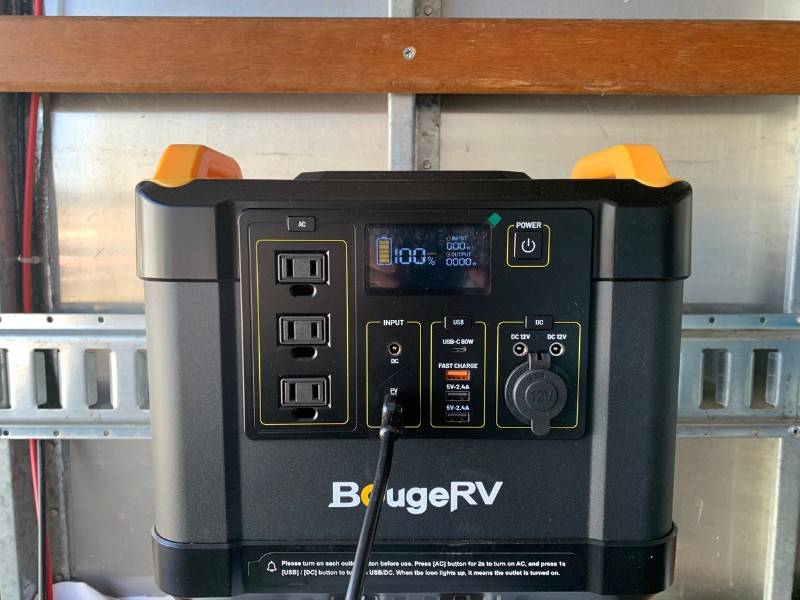
The very first thing we noticed was the build quality of this solar power generator.
I must say, our team was quite impressed with the build quality. The top part and the handles are made of plastic, but the rest of the body is made of aluminum.
We loved that BougeRV has included an aluminum exhaust vent.
The use of aluminum and plastic keeps the overall weight in check as well. It’s evident that BougeRV made this solar generator with portability in mind.
We did encounter an error in the installation manual. On page 8, it showed incorrect polarity on two of the MC4 connectors.
We reached out to BougeRV, and in less than 24 hours, we got a response that their team had taken the feedback and updated the manual. So, future printings will have the correct polarity displayed.
Kudos to BougeRV!
Understanding the BougeRV Power Station: A Quick Overview
On paper, the BougeRV solar generator seems like an amazing deal. You’re getting an 1120Wh LiFePO4 battery pairing with a 1200W pure sine wave inverter.
Let’s take a look at the official (advertised) key specifications of BougeRV FORT 1000:
| |
|---|
| |
| |
| 3500+ Cycles to 80% Capacity |
Rated Power Output (PSW Inverter) | |
| |
| |
| |
| |
| |
| |
All of that is just around the $1,150 price point (at the time of writing).
The price can go even lower as BougeRV offers 30% to 40% off under various deals. So, you can buy one at $700!
The Best BougeRV Power Station Deals
But here’s the catch — the performance of the product is underwhelming.
For example, we’re getting anywhere from 600Wh to 900Wh of power capacity. Every test run offered a different value, and the numbers were widely inconsistent.
A typical LiFePO4 battery should have an efficiency of 90% in the best-case scenario.
So, we should be getting over 1000Wh of power consistently, which was not the case here.
It even fails to deliver the efficiency standards of older lead-acid batteries, about 80%.
Then, we noticed the same pattern while recharging the solar power station.
Sometimes, it took 23 hours to recharge. But some other times, it would take more than 40 hours to recharge fully via solar.
This unreliability can be a big hassle if you’re taking this solar generator for off-grid camping.
You could be totally powerless!
Additionally, we noticed random shutdowns without any warning whatsoever. You can never know how long it’ll actually last.
Maybe we got a faulty unit, maybe not — who's to say here?
How Was The Installation Experience?
Okay, let’s start from the beginning — with the installation experience. BougeRV deserves some credit here.
Installing BougeRV Solar Panel
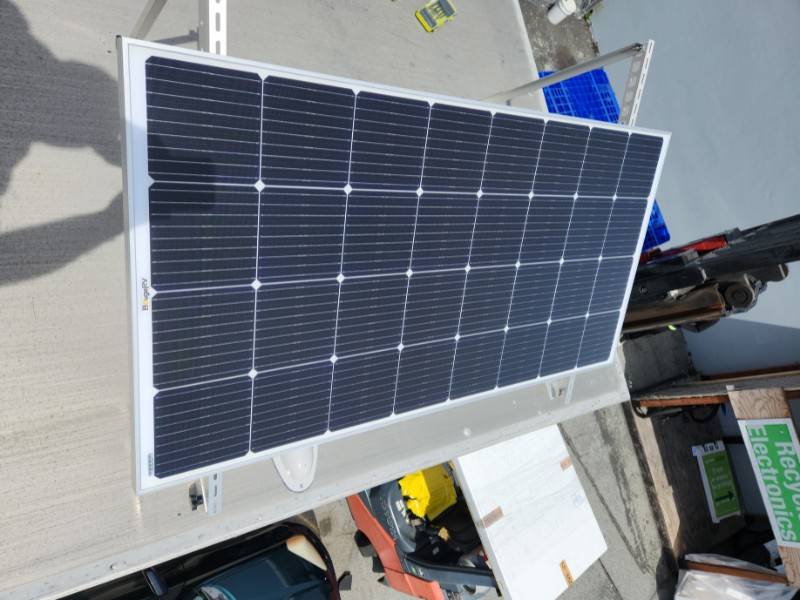
Overall, the installation process went smoothly. We started by installing the BougeRV 200W 12V 9BB Mono Solar Panel over one of our trucks.
We tried their Z Bracket Mount Kits and the Adjustable Solar Panel Tilt Mount Brackets. Both of them are of decent quality. They came with stainless steel bolts, nuts, washers, and screws.
The brackets themselves are made of aluminum.
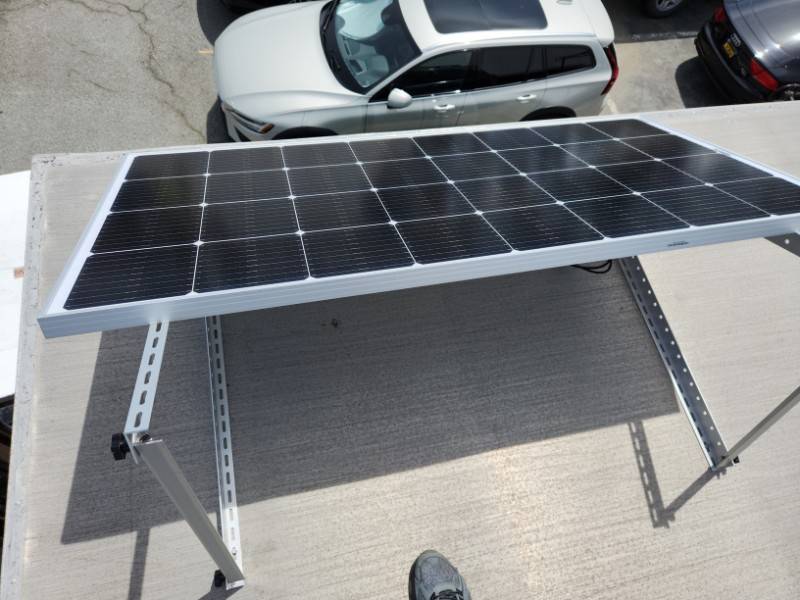
So, you shouldn’t expect any rust. Individually, both should have fantastic all-weather-resistant properties.
Still, we will have to observe long-term to see if any galvanic corrosion develops. Even if it does develop, it should not cause any major issues. We would like to see some additional bolts, nuts, and washers.
One thing I’d like to mention here.
We didn’t receive any lock washers with the products. Lock washers hold the bolts in place and come in very handy to secure the joints. Their website mentions that lock washers are included. So, hopefully, all future kits will include them.
We also used BougeRV’s Solar Double Cable Entry Gland Box for the installation. Again, we don’t have any complaints against it — it’s thick, durable ABS plastic that should withstand harsh weather.
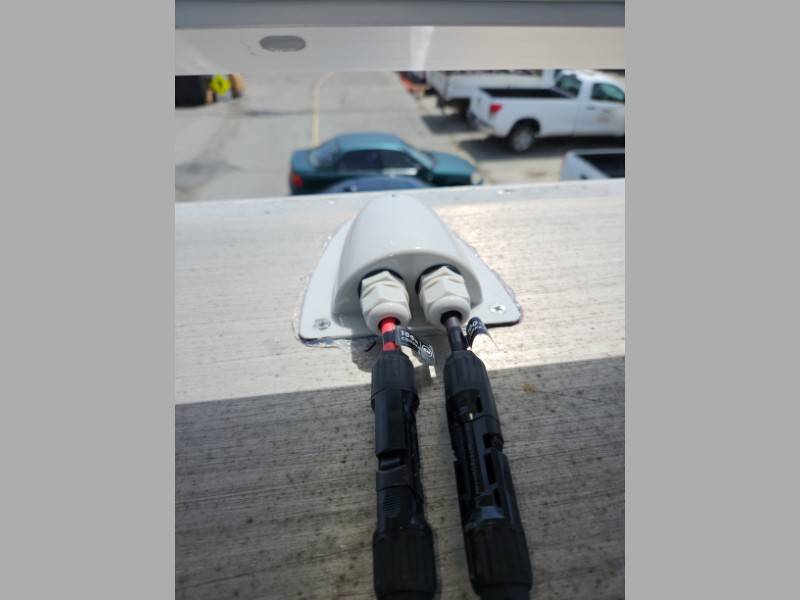
We installed it with a silicone-based UV-resistant caulking that is waterproof and can tolerate extreme cold or hot temperature swings.
Hopefully, BougeRV will include some grommets as well.
The cables are supposed to go through the siding of a vehicle or other structure, and for our truck installation, it had to go through several thin sheets of aluminum. We wrapped the cables in tape to prevent chafing, but grommets would’ve been a better solution.
The extension cable that came with the panels also had solid build quality, with all connectors IP65 rated.
Is the BougeRV Solar Power Station Reliable?
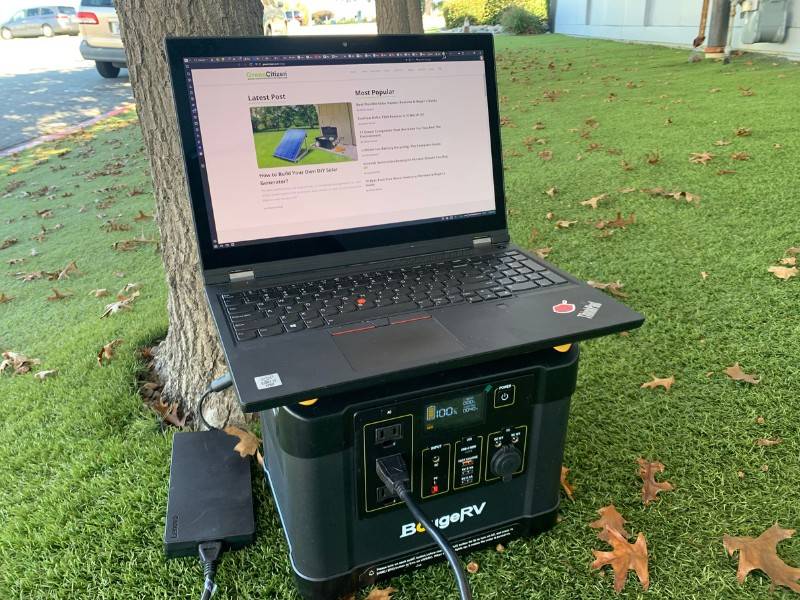
In one word — NO!
Our main concern was that the power station didn't provide enough information on how much power was remaining and when it would turn off.
As I said, our installation experience went smoothly. The build quality of the solar panel and the power station felt excellent.
We really had to nitpick to find flaws.
Sadly, the same thing can’t be said about our usage experience.
First, we tried eleven 100% to 0% discharge tests.
On our first test run, we gave it a 770W load and tried to measure how long it takes to discharge the battery fully.
Surprisingly, it only lasted for 45 minutes!
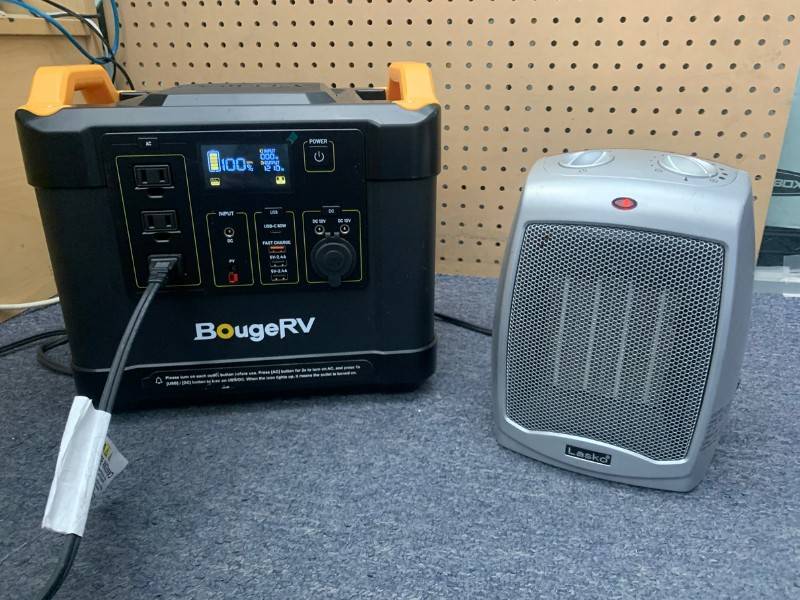
Moreover, the BougeRV battery dropped to 0% and got disconnected from the appliance immediately once the battery reached 20%.
But on our second test run, for the same 770W load, the battery lasted for 55 minutes. This time, the appliance got disconnected when the battery reached a 6% charge.
Each of our test runs produced different results.
Just take a look at the BougeRV real-life benchmark data,
Test Run # | Load | 100% to 0% Timing | Notes |
1 | 770W | 45 minutes | Dropped immediately to 0 and disconnected AC once it hit 20%. |
2 | 770W | 55 minutes | Disconnected AC when reached 6%. |
3 | 770W | 45 minutes | Disconnected AC when reached 20%. |
4 | 110-130W | 7 hours 33 minutes | Disconnected AC when reached 0%. |
5 | 25W | 29 hours 40 minutes | Disconnected AC when reached 1%. |
6 | 25W | 31 hours | Disconnected AC when reached 0%. |
7 | 90W | 8 hours 50 minutes | Disconnected AC when reached 5%. |
8 | 82-88W | 10 hours 30 minutes | Disconnected AC when reached 0%. |
9 | 82-88W | 10 hours 55 minutes | Disconnected AC when reached 0%. |
Now, these numbers vary from the official numbers from BougeRV.

For example, BougeRV says an 800W microwave should run for 1 hour and 6 minutes. However, our test runs show an appliance with a 770W load can be run for about 45 minutes.
Plus, the appliance can get disconnected at 20% battery level.
Then again, if you look at Test Run 7 and Test Run 9, you’ll see a 90-ish-watt appliance can run anywhere from 8 hours 50 minutes to 10 hours 55 minutes.
Clearly, reliability and consistency are major issues here.
Why Isn’t My 1120Wh BougeRV Delivering All of The Energy?
This is an interesting topic.
Your BougeRV 1100Wh portable power station can never deliver the advertised 1120Wh energy — it’s not scientifically possible!
Our complaint wasn’t about the lower-than-advertised battery power capacity but was about the inconsistency that the generator shows.
If it delivers 900Wh of power capacity, it should always do it for all appliances.
An even bigger issue was we never had an accurate warning about when it would power down; it just randomly cuts power.
In practical terms, no battery delivers 100% of its advertised watt-hours (Wh) for several reasons:
- Internal Resistance: All batteries have some internal resistance, which causes energy losses in the form of heat when the battery is discharged.
- Peukert's Law: This principle applies to lead-acid batteries (like car batteries) and describes how the capacity of a battery decreases as the rate of discharge increases.
- Battery Efficiency: Not all the stored energy in a battery can be used effectively. Some energy is lost during the charging and discharging process, especially in chemistries like lead-acid. Lithium-ion batteries are more efficient, often achieving 85-95% efficiency, but they still don't deliver 100%.
- Depth of Discharge (DoD): Continuously discharging a battery to its maximum DoD can severely shorten its lifespan. As a result, many battery systems are designed to limit the depth of discharge to protect the battery. For example, a battery might only be discharged to 80% of its capacity to ensure a longer life.
- Operational Conditions: Temperature, load fluctuations, and other external conditions can impact a battery's performance and its ability to deliver the full advertised capacity.
- Battery Aging: As batteries age, their capacity diminishes. An older battery won't provide as much energy as when it was new.
- BMS (Battery Management System): Many modern batteries, especially lithium-ion ones, have a BMS that ensures the battery operates within safe parameters. This system can limit the power output to prevent damage, further reducing the effective capacity under certain conditions.
That said, when manufacturers list a battery's capacity, they often refer to ideal conditions or standardized testing scenarios. In real-world applications, numerous factors, as mentioned above, will reduce the actual usable capacity.
This is what’s happening with your BougeRV battery.
Below Average Solar Charging Speed
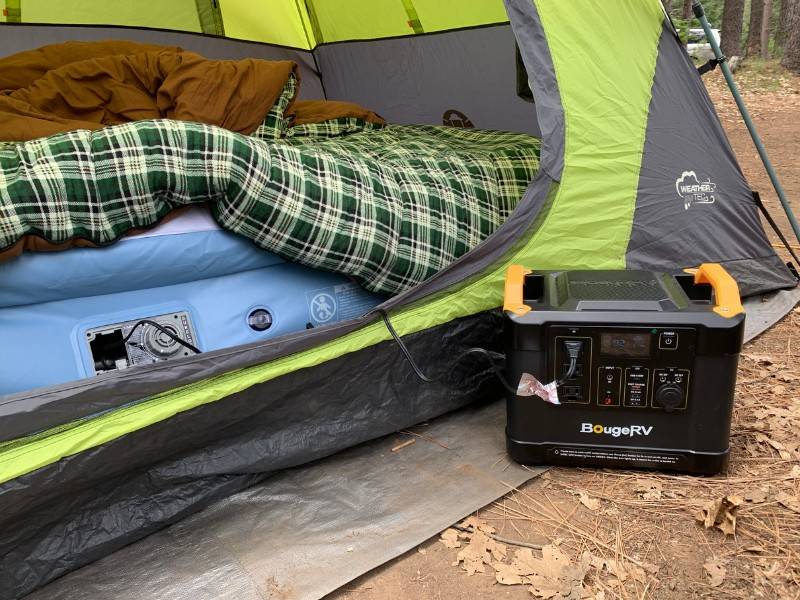
Just like the discharge tests, we’ve also conducted some recharging tests.
The official statement from BougeRV says, “It takes only 4.5-5.5 hours to recharge a Portable Power Station with the Bouge RV solar panel.”
We conducted six solar charging tests for the BougeRV Fort 1000 solar generator.
It took over one and a half days to fully charge the battery. And we’re based in the San Francisco Bay Area, where we get more than eight hours of sunlight daily.
Now, it’s true that we had off-and-on overcast during the days of the tests.
But in none of our test conditions should it take more than one and a half days.
Here are the detailed solar recharging benchmarks:
Test Run | Charge Start | Charge End | Duration | Testing Notes |
1 | 12:30, April 26 | 13:00, April 27 | 24 hours 30 minutes |
2 | 14:15, April 27 | 14:00, April 28 | 23 hours 45 minutes |
3 | 11:05, May 1 | 16:45, May 2 | 29 hours 40 minutes | Overcast on and off |
4 | 11:20, May 4 | 19:40, May 5 | 32 hours 20 minutes | Overcast on and off |
5 | 15:40, May 8 | 18:40, May 9 | 27 hours | Overcast on and off |
6 | 17:05, May 10 | 12:30, May 12 | 43 hours 25 minutes | Overcast on and off |
Note: The test data measures 0-100% solar recharge times. We noticed the power station would charge 70-90% of the capacity under peak sunlight in about 5 hours. The 10-30% solar charging would happen slowly due to less than ideal lighting conditions later in the day and night. This issue is not unique to any specific system but is an inherent drawback of current solar charging technology
BougeRV Power Station: Is It All Bad? NO!
Just like all other products in the world, BougeRV is not perfect.
But there are many areas where BougeRV shines.
The Budget-Friendly Power Station
The First thing that comes to my mind is the pricing. With proper deals, you can get a BougeRV Fort 1000 for about $700 as of the time of writing this product review.
A comparable product with similar tech specs would cost you about a thousand bucks.
We think BougeRV is serving a budget segment. Budget products can’t actually compete with premium options.
Just think for a moment: can a budget $200 Samsung compete with a $1000+ iPhone?
However, you need to think twice and consider the performance inconsistencies.
Also, keep in mind that without any deals or coupon codes, you might have to pay $1156 for this power station.
At this price point, you can find something like Bluetti AC200P, which offers twice the power output and battery capacity on paper.
A Decent Build Quality
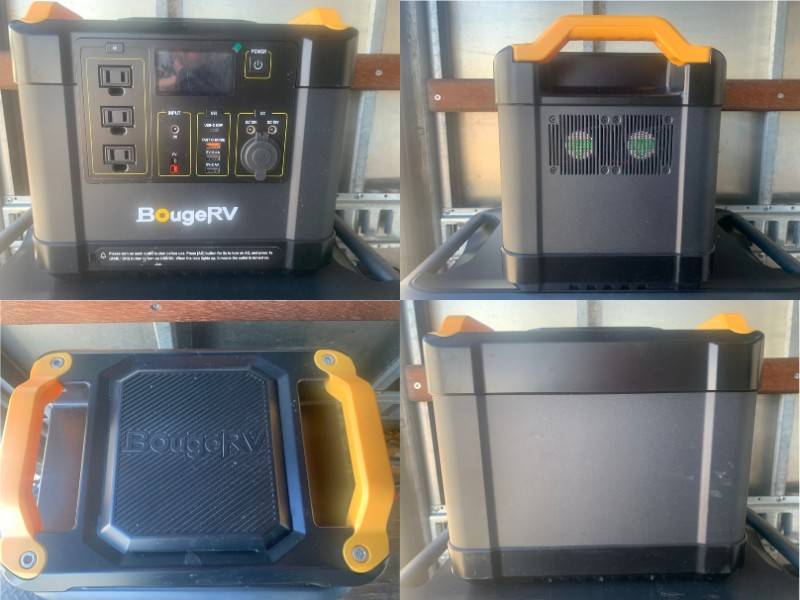
The second thing that we loved was the build quality.
Like we said before, it has a solid build quality — it doesn't show any sign of bends or cracks. Plus, the aluminum and plastic body ensures a weight advantage.
Thanks to its compact form factor and weight, it will fit easily in everyone’s trunk, and there’ll still be plenty of room for camping supplies.
Still, 28 lbs might still be too heavy for someone to lift, so BougeRV has provided two solid carrying handles at the top. The handles are just simple plastic, not rubbery, but very grippy, so I have no trouble carrying the unit in one hand.
A Good Port Selection
One of the things I like about this power station is that everything is grouped and nicely labeled, so there’s no room for error as to what goes where.
At the front side, the BougeRV Fort 1000 has a total of 12 ports grouped as:
| |
|---|
| |
| |
| |
USB-C input and output (60W max) | |
USB-A 3.0 output (fast charge) | |
| |
| |
| |
All in all, the BougeRV has plenty of high-power and low-power ports to charge and run pretty much anything you can take camping with you.
But I believe they could’ve added one or two wireless charging pads. It’s not a big downside, but I think Bluetti has spoiled me.
The built-in inverter delivers pure-sine wave current at the AC outlets, so this power station is safe to use for charging sensitive electronics like smartphones, tablets, and laptops.
Industry Leading Warranty Policy
This is where BougeRV has shocked me. They’re offering a 5-year warranty for the BougeRV Fort 1000. Plus, if you buy from their website, you’ll get an additional two years of warranty.
So, technically, you’re getting a 7-year warranty.
Even the industry leader Bluetti is offering four years of warranty. Jackery offers two years, and EcoFlow offers five years of warranty.
The Best BougeRV Power Station Deals
The Good, The Bad, and The Verdict
- Good build quality
- 12 ports in total
- 7-year warranty (conditional)
- Compact form factor
- LiFePO4 battery
- Excellent ventilation while maintaining low noise levels
- Built-in MPPT charge controller
- Unreliable power capacity
- Below-average battery efficiency
- Performance inconsistency
- Slow solar charging speed
- No charging pads
- There is no mobile app
BougeRV vs. The Competition: A Comparative Analysis
You can understand the true worth of a product when you compare it against the competitors.
For a fair comparison, we’ll consider products in the same budget segment, offering a similar spec sheet. So, we’ll take a look at the solar power stations at a $1000-ish price point that have 1000W power delivery or 1000Wh battery capacity.
Here are some of the competitors that match our criteria:
- Bluetti AC180
- Jackery Explorer 1000
- EcoFlow DELTA 2
Bluetti vs BougeRV Power Station
Bluetti started its journey as a Kickstarter project. This crowdfunded company soon became a fan-favorite.
Some even think that Bluetti has already become the market leader in terms of having the highest quality products.
If you want a BougeRV Fort 1000 alternative from Bluetti, I think the AC180 should be the model.
The Bluetti AC180 offers a higher AC output of 1,800W and a power-lifting mode of 2,700W, compared to the BougeRV's 1,200W AC output and 2,000W peak.
It even boasts a larger capacity of 1,152Wh that can consistently deliver the promised power capacity. In our tests, they maintained 90% efficiency consistently.
And, based on our tests, you already know how inconsistent BougeRV is.
Bluetii power station even offers some nice-to-have features, like the 15W charging pad and smartphone app.
It comes at a slightly higher original price, but the discounted prices make both units competitively priced.
The Best Bluetti AC180 Deals
Jackery vs BougeRV Power Station
Jackery is probably the most well-known brand in the solar generator market. From this brand, we’re choosing the Jackery Explorer 1000.
On paper, Jackery 1000 seems like an inferior product.
For example, Jackery offers a 1000W power output compared to the 1200W output offered by BougeRV. BougeRV also offers a higher 1120Wh battery capacity. Jackery, on the other hand, has a battery capacity of 1,002Wh.
Jackery even offers the outdated lithium-ion cell technology, which has 500 cycles until the battery health falls to 80%.
So, why are we even considering Jackery 1000?
In one word — reliability.
Jackery Explorer 1000 might be a weaker product on paper, but it’s a tested and proven product. The users have showered this product with praise as it is a dependable product. You can just take this product camping without any worries.
You can learn more from our complete Jackery 1000 review.
The Best Jackery 1000 Deals
EcoFlow vs BougeRV Solar Generator
EcoFlow is another big name in the market.
From EcoFlow, we’re choosing the EcoFlow Delta 2 power station.
EcoFlow has 1800W power output, and with its proprietary X-boost technology, you can get 2200W output.
And this is not the surge output. The surge output is 2700W of this product.
The base variant offers 1024Wh battery capacity, but you can attach additional batteries and increase the capacity to 3000Wh.
Wait, there’s more!
EcoFlow has another amazing technology called X-Stream. This is an ultra-fast-charging technology that can charge the EcoFlow power station (0-80%) in just 50 minutes.
You can get this product at around $699 after the discount, and the MSRP is $999.
The Best EcoFlow Delta 2 Deals
BougeRV Power Station Review: Worth It?
In the end, it all boils down to your preferences.
There are many things to like about the BougeRV Fort 1000 — build quality, form factor, low operational noise, warranty policy, and the inclusion of the new LiFePO4 battery.
The spec sheet (on paper) is impressive
Sadly, our real-life testing data painted a different picture, especially in the battery capacity and solar charging department.
The question is — how much do the flaws bother you?
If you don’t think the flaws matter to you, or you can overlook them, the BougeRV power station can be a reasonable choice.
Do you own a BougeRV Fort 1000? What is your experience with the product?
Let us know in the comment section.
Green Blog
BougeRV Power Station Review: Can It Truly Deliver?
Written by : Samira Tasneem | Last Updated: November 21, 2023
Contents
Is BougeRV Power Station the answer to your power needs? Read our comprehensive review on its performance, build quality, and reliability.
Disclaimer: BougeRV provided GreenCitizen with a BougeRV FORT 1000 power station for evaluation purposes but had no input in the review.
As power outages are becoming more and more rampant around the world, the demand for dependable power stations is increasing.
We’re seeing a surge of new brands in the market trying to meet the demand for solar power stations. And, BougeRV is one of such new names. Being solar generator advocates, we at GreenCitizen were very eager to test out the new BougeRV FORT 1000.
We ran dozens of load tests, charging and discharging tests, and even took it camping to understand its capabilities.
The results?
We appreciate the build-quality and newer-generation battery cell technology. However, the battery capacity was unreliable and widely inconsistent. Also, the solar charging speed was underwhelming.
Apart from the review, we’ll also compare the BougeRV power station with some of the big names in the market, such as Bluetti, EcoFlow, or Jackery.
Let’s not waste more words and jump straight to the detailed review section.
Installing BougeRV Power Station: First Impression
The very first thing we noticed was the build quality of this solar power generator.
I must say, our team was quite impressed with the build quality. The top part and the handles are made of plastic, but the rest of the body is made of aluminum.
We loved that BougeRV has included an aluminum exhaust vent.
The use of aluminum and plastic keeps the overall weight in check as well. It’s evident that BougeRV made this solar generator with portability in mind.
We did encounter an error in the installation manual. On page 8, it showed incorrect polarity on two of the MC4 connectors.
We reached out to BougeRV, and in less than 24 hours, we got a response that their team had taken the feedback and updated the manual. So, future printings will have the correct polarity displayed.
Kudos to BougeRV!
Understanding the BougeRV Power Station: A Quick Overview
On paper, the BougeRV solar generator seems like an amazing deal. You’re getting an 1120Wh LiFePO4 battery pairing with a 1200W pure sine wave inverter.
Let’s take a look at the official (advertised) key specifications of BougeRV FORT 1000:
Criteria
Specification
Battery Capacity
1120Wh
Battery Cell Type
LiFePO4
Life Cycles
3500+ Cycles to 80% Capacity
Rated Power Output (PSW Inverter)
1200W
Surge Power Output
2000W
DC Input (DC5521)
200W (Max)
Solar Input
200W (Max)
Product Dimension
12.6 x 9 x 11.4 (Inches)
Weight
28.7 lbs. (13 kg)
Product Warranty
5+2 Years
All of that is just around the $1,150 price point (at the time of writing).
The price can go even lower as BougeRV offers 30% to 40% off under various deals. So, you can buy one at $700!
The Best BougeRV Power Station Deals
But here’s the catch — the performance of the product is underwhelming.
For example, we’re getting anywhere from 600Wh to 900Wh of power capacity. Every test run offered a different value, and the numbers were widely inconsistent.
A typical LiFePO4 battery should have an efficiency of 90% in the best-case scenario.
So, we should be getting over 1000Wh of power consistently, which was not the case here.
It even fails to deliver the efficiency standards of older lead-acid batteries, about 80%.
Then, we noticed the same pattern while recharging the solar power station.
Sometimes, it took 23 hours to recharge. But some other times, it would take more than 40 hours to recharge fully via solar.
This unreliability can be a big hassle if you’re taking this solar generator for off-grid camping.
You could be totally powerless!
Additionally, we noticed random shutdowns without any warning whatsoever. You can never know how long it’ll actually last.
Maybe we got a faulty unit, maybe not — who's to say here?
How Was The Installation Experience?
Okay, let’s start from the beginning — with the installation experience. BougeRV deserves some credit here.
Installing BougeRV Solar Panel
Overall, the installation process went smoothly. We started by installing the BougeRV 200W 12V 9BB Mono Solar Panel over one of our trucks.
We tried their Z Bracket Mount Kits and the Adjustable Solar Panel Tilt Mount Brackets. Both of them are of decent quality. They came with stainless steel bolts, nuts, washers, and screws.
The brackets themselves are made of aluminum.
So, you shouldn’t expect any rust. Individually, both should have fantastic all-weather-resistant properties.
Still, we will have to observe long-term to see if any galvanic corrosion develops. Even if it does develop, it should not cause any major issues. We would like to see some additional bolts, nuts, and washers.
One thing I’d like to mention here.
We didn’t receive any lock washers with the products. Lock washers hold the bolts in place and come in very handy to secure the joints. Their website mentions that lock washers are included. So, hopefully, all future kits will include them.
We also used BougeRV’s Solar Double Cable Entry Gland Box for the installation. Again, we don’t have any complaints against it — it’s thick, durable ABS plastic that should withstand harsh weather.
We installed it with a silicone-based UV-resistant caulking that is waterproof and can tolerate extreme cold or hot temperature swings.
Hopefully, BougeRV will include some grommets as well.
The cables are supposed to go through the siding of a vehicle or other structure, and for our truck installation, it had to go through several thin sheets of aluminum. We wrapped the cables in tape to prevent chafing, but grommets would’ve been a better solution.
The extension cable that came with the panels also had solid build quality, with all connectors IP65 rated.
Is the BougeRV Solar Power Station Reliable?
In one word — NO!
Our main concern was that the power station didn't provide enough information on how much power was remaining and when it would turn off.
As I said, our installation experience went smoothly. The build quality of the solar panel and the power station felt excellent.
We really had to nitpick to find flaws.
Sadly, the same thing can’t be said about our usage experience.
First, we tried eleven 100% to 0% discharge tests.
On our first test run, we gave it a 770W load and tried to measure how long it takes to discharge the battery fully.
Surprisingly, it only lasted for 45 minutes!
Moreover, the BougeRV battery dropped to 0% and got disconnected from the appliance immediately once the battery reached 20%.
But on our second test run, for the same 770W load, the battery lasted for 55 minutes. This time, the appliance got disconnected when the battery reached a 6% charge.
Each of our test runs produced different results.
Just take a look at the BougeRV real-life benchmark data,
Test Run #
Load
100% to 0% Timing
Notes
1
770W
45 minutes
Dropped immediately to 0 and disconnected AC once it hit 20%.
2
770W
55 minutes
Disconnected AC when reached 6%.
3
770W
45 minutes
Disconnected AC when reached 20%.
4
110-130W
7 hours 33 minutes
Disconnected AC when reached 0%.
5
25W
29 hours 40 minutes
Disconnected AC when reached 1%.
6
25W
31 hours
Disconnected AC when reached 0%.
7
90W
8 hours 50 minutes
Disconnected AC when reached 5%.
8
82-88W
10 hours 30 minutes
Disconnected AC when reached 0%.
9
82-88W
10 hours 55 minutes
Disconnected AC when reached 0%.
Now, these numbers vary from the official numbers from BougeRV.
For example, BougeRV says an 800W microwave should run for 1 hour and 6 minutes. However, our test runs show an appliance with a 770W load can be run for about 45 minutes.
Plus, the appliance can get disconnected at 20% battery level.
Then again, if you look at Test Run 7 and Test Run 9, you’ll see a 90-ish-watt appliance can run anywhere from 8 hours 50 minutes to 10 hours 55 minutes.
Clearly, reliability and consistency are major issues here.
Why Isn’t My 1120Wh BougeRV Delivering All of The Energy?
This is an interesting topic.
Your BougeRV 1100Wh portable power station can never deliver the advertised 1120Wh energy — it’s not scientifically possible!
Our complaint wasn’t about the lower-than-advertised battery power capacity but was about the inconsistency that the generator shows.
If it delivers 900Wh of power capacity, it should always do it for all appliances.
An even bigger issue was we never had an accurate warning about when it would power down; it just randomly cuts power.
In practical terms, no battery delivers 100% of its advertised watt-hours (Wh) for several reasons:
That said, when manufacturers list a battery's capacity, they often refer to ideal conditions or standardized testing scenarios. In real-world applications, numerous factors, as mentioned above, will reduce the actual usable capacity.
This is what’s happening with your BougeRV battery.
Below Average Solar Charging Speed
Just like the discharge tests, we’ve also conducted some recharging tests.
The official statement from BougeRV says, “It takes only 4.5-5.5 hours to recharge a Portable Power Station with the Bouge RV solar panel.”
We conducted six solar charging tests for the BougeRV Fort 1000 solar generator.
It took over one and a half days to fully charge the battery. And we’re based in the San Francisco Bay Area, where we get more than eight hours of sunlight daily.
Now, it’s true that we had off-and-on overcast during the days of the tests.
But in none of our test conditions should it take more than one and a half days.
Here are the detailed solar recharging benchmarks:
Test Run
Charge Start
Charge End
Duration
Testing Notes
1
12:30, April 26
13:00, April 27
24 hours 30 minutes
2
14:15, April 27
14:00, April 28
23 hours 45 minutes
3
11:05, May 1
16:45, May 2
29 hours 40 minutes
Overcast on and off
4
11:20, May 4
19:40, May 5
32 hours 20 minutes
Overcast on and off
5
15:40, May 8
18:40, May 9
27 hours
Overcast on and off
6
17:05, May 10
12:30, May 12
43 hours 25 minutes
Overcast on and off
Note: The test data measures 0-100% solar recharge times. We noticed the power station would charge 70-90% of the capacity under peak sunlight in about 5 hours. The 10-30% solar charging would happen slowly due to less than ideal lighting conditions later in the day and night. This issue is not unique to any specific system but is an inherent drawback of current solar charging technology
BougeRV Power Station: Is It All Bad? NO!
Just like all other products in the world, BougeRV is not perfect.
But there are many areas where BougeRV shines.
The Budget-Friendly Power Station
The First thing that comes to my mind is the pricing. With proper deals, you can get a BougeRV Fort 1000 for about $700 as of the time of writing this product review.
A comparable product with similar tech specs would cost you about a thousand bucks.
We think BougeRV is serving a budget segment. Budget products can’t actually compete with premium options.
Just think for a moment: can a budget $200 Samsung compete with a $1000+ iPhone?
However, you need to think twice and consider the performance inconsistencies.
Also, keep in mind that without any deals or coupon codes, you might have to pay $1156 for this power station.
At this price point, you can find something like Bluetti AC200P, which offers twice the power output and battery capacity on paper.
A Decent Build Quality
The second thing that we loved was the build quality.
Like we said before, it has a solid build quality — it doesn't show any sign of bends or cracks. Plus, the aluminum and plastic body ensures a weight advantage.
Thanks to its compact form factor and weight, it will fit easily in everyone’s trunk, and there’ll still be plenty of room for camping supplies.
Still, 28 lbs might still be too heavy for someone to lift, so BougeRV has provided two solid carrying handles at the top. The handles are just simple plastic, not rubbery, but very grippy, so I have no trouble carrying the unit in one hand.
A Good Port Selection
One of the things I like about this power station is that everything is grouped and nicely labeled, so there’s no room for error as to what goes where.
At the front side, the BougeRV Fort 1000 has a total of 12 ports grouped as:
Type of Port
Quantity
110V AC outlets
3
25V 5521DC input
1
12-30V solar input
1
USB-C input and output (60W max)
1
USB-A 3.0 output (fast charge)
1
USB-A output
2
12V DC5521 output
2
12V cigarette port
1
All in all, the BougeRV has plenty of high-power and low-power ports to charge and run pretty much anything you can take camping with you.
But I believe they could’ve added one or two wireless charging pads. It’s not a big downside, but I think Bluetti has spoiled me.
The built-in inverter delivers pure-sine wave current at the AC outlets, so this power station is safe to use for charging sensitive electronics like smartphones, tablets, and laptops.
Industry Leading Warranty Policy
This is where BougeRV has shocked me. They’re offering a 5-year warranty for the BougeRV Fort 1000. Plus, if you buy from their website, you’ll get an additional two years of warranty.
So, technically, you’re getting a 7-year warranty.
Even the industry leader Bluetti is offering four years of warranty. Jackery offers two years, and EcoFlow offers five years of warranty.
The Best BougeRV Power Station Deals
The Good, The Bad, and The Verdict
Pros
Cons
BougeRV vs. The Competition: A Comparative Analysis
You can understand the true worth of a product when you compare it against the competitors.
For a fair comparison, we’ll consider products in the same budget segment, offering a similar spec sheet. So, we’ll take a look at the solar power stations at a $1000-ish price point that have 1000W power delivery or 1000Wh battery capacity.
Here are some of the competitors that match our criteria:
Bluetti vs BougeRV Power Station
Bluetti started its journey as a Kickstarter project. This crowdfunded company soon became a fan-favorite.
Some even think that Bluetti has already become the market leader in terms of having the highest quality products.
If you want a BougeRV Fort 1000 alternative from Bluetti, I think the AC180 should be the model.
The Bluetti AC180 offers a higher AC output of 1,800W and a power-lifting mode of 2,700W, compared to the BougeRV's 1,200W AC output and 2,000W peak.
It even boasts a larger capacity of 1,152Wh that can consistently deliver the promised power capacity. In our tests, they maintained 90% efficiency consistently.
And, based on our tests, you already know how inconsistent BougeRV is.
Bluetii power station even offers some nice-to-have features, like the 15W charging pad and smartphone app.
It comes at a slightly higher original price, but the discounted prices make both units competitively priced.
The Best Bluetti AC180 Deals
Jackery vs BougeRV Power Station
Jackery is probably the most well-known brand in the solar generator market. From this brand, we’re choosing the Jackery Explorer 1000.
On paper, Jackery 1000 seems like an inferior product.
For example, Jackery offers a 1000W power output compared to the 1200W output offered by BougeRV. BougeRV also offers a higher 1120Wh battery capacity. Jackery, on the other hand, has a battery capacity of 1,002Wh.
Jackery even offers the outdated lithium-ion cell technology, which has 500 cycles until the battery health falls to 80%.
So, why are we even considering Jackery 1000?
In one word — reliability.
Jackery Explorer 1000 might be a weaker product on paper, but it’s a tested and proven product. The users have showered this product with praise as it is a dependable product. You can just take this product camping without any worries.
You can learn more from our complete Jackery 1000 review.
The Best Jackery 1000 Deals
EcoFlow vs BougeRV Solar Generator
EcoFlow is another big name in the market.
From EcoFlow, we’re choosing the EcoFlow Delta 2 power station.
EcoFlow has 1800W power output, and with its proprietary X-boost technology, you can get 2200W output.
And this is not the surge output. The surge output is 2700W of this product.
The base variant offers 1024Wh battery capacity, but you can attach additional batteries and increase the capacity to 3000Wh.
Wait, there’s more!
EcoFlow has another amazing technology called X-Stream. This is an ultra-fast-charging technology that can charge the EcoFlow power station (0-80%) in just 50 minutes.
You can get this product at around $699 after the discount, and the MSRP is $999.
The Best EcoFlow Delta 2 Deals
BougeRV Power Station Review: Worth It?
In the end, it all boils down to your preferences.
There are many things to like about the BougeRV Fort 1000 — build quality, form factor, low operational noise, warranty policy, and the inclusion of the new LiFePO4 battery.
The spec sheet (on paper) is impressive
Sadly, our real-life testing data painted a different picture, especially in the battery capacity and solar charging department.
The question is — how much do the flaws bother you?
If you don’t think the flaws matter to you, or you can overlook them, the BougeRV power station can be a reasonable choice.
Do you own a BougeRV Fort 1000? What is your experience with the product?
Let us know in the comment section.
Samira Tasneem
Samira is an Electronics and Communications Engineer by profession, but deep inside, her heart is a nomad! She's a state champion debater, a public speaker, a scriptwriter, a theater actress, but most importantly — A GREEN CITIZEN! She thinks of herself as a storyteller who thrives on enjoying the life at fullest and telling everyone the tales of life.
Quick Links
Green Living Guides
Green Jobs
Inspiring Green News
Green Directory
Green Store
Electronics Recycling
Category: Green Blog, Product Review, Renewable Energy, Solar Power